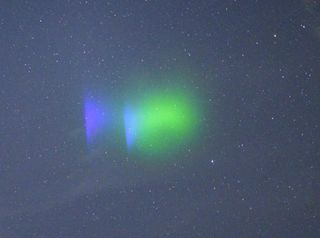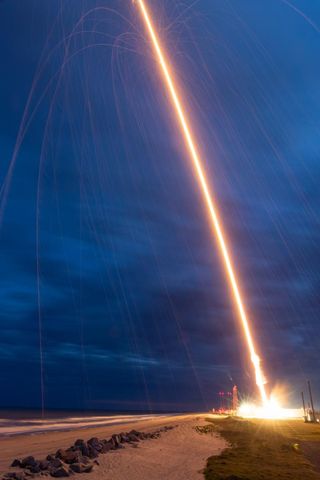NASA rocket launch sparks stunning green and violet clouds in night sky (photos)
The mission studied energy transfer in space.

A suborbital launch created violet and green lights in the sky this weekend in a larger effort to understand spaceborne energy transport.
The "series finale" of the KiNET-X mission successfully launched Sunday (May 16) at 8:44 p.m. EDT (0044 May 17 GMT) on a Black Brant XII rocket, from NASA's Wallops Flight Facility in Virginia, the agency announced early Monday (May 17) via Twitter. The pictures probably showed more intense colors than the naked eye, as violet doesn't show up well to humans against the black background of the night sky.
The mission, also called the Kinetic-scale Energy and Momentum Transport Experiment, aims to better understand how energy and momentum transfer in phenomena like auroras, between "different regions of space that are magnetically connected," NASA said in a mission description.
Related: These NASA rocket launches to study Earth's atmosphere are just gorgeous (photos)

Auroras on our planet arise from solar particles that flow along the magnetic north and south poles of the Earth. The so-called "northern lights" or "southern lights" occur after particles pass through the Earth's magnetic shield and interact with atoms and molecules of oxygen, nitrogen and other elements.
Yet scientists are still puzzled by how energies transfer in auroras, despite having studied them on Earth for centuries and on other planets for decades. "The electrons in Earth's space environment and in the solar wind have relatively low energies," Peter Delamere, KiNET-X principal investigator from the University of Alaska, Fairbanks, said in the mission description.
The experiment included a suborbital rocket launch with seven payloads that separated in Earth's upper atmosphere. Two of the payloads released barium vapor clouds (which are harmless to the environment) in the upper atmosphere, while the other five payloads carried instrumentation to document the effects.
Get the Space.com Newsletter
Breaking space news, the latest updates on rocket launches, skywatching events and more!
The vapor was released roughly 10 minutes after launch between an altitude of 217 miles to 249 miles (349 km to 400 km) above the Atlantic Ocean, just north of Bermuda, according to NASA.
"After exposure to sunlight the vapor clouds quickly ionize and take on a violet color," NASA added in the mission description. "Immediately after release of the vapor, the spherical clouds are a mixture of green and violet, but that phase only lasts about 30 seconds when the un-ionized component of the cloud has diffused away."

The portion of the cloud that was ionized, or that carries an electrical charge, diffused parallel to the magnetic field lines in the region. Because mid-Atlantic latitudes have field lines inclined 45 degrees to the horizontal, NASA said, "the violet clouds stretch out in a slanted orientation and look more like short trails than a cloud."
Neutral regions of the clouds, by contrast, were not affected by magnetic field lines and spread out more quickly than the ionized regions.
Implications for this experiment extend well beyond Earth, as the scientists are also interested in understanding Jupiter's interactions with one of its large moons, Io — the most volcanically active world in the solar system. Io's atmosphere and Jupiter's space environment together create an auroral spot in Jupiter's atmosphere.
"KiNET-X is like a mini-Io. Two barium vapor clouds emitted from the rocket's payload will generate a magnetic field perturbation, and electrons are likely to be energized," NASA said. KiNET-X, with easily measurable inputs, is expected to help scientists better understand how energy flows to the electrons or negatively charged particles the experiment produced, the agency added.
Follow Elizabeth Howell on Twitter @howellspace. Follow us on Twitter @Spacedotcom and on Facebook.
Join our Space Forums to keep talking space on the latest missions, night sky and more! And if you have a news tip, correction or comment, let us know at: community@space.com.

Elizabeth Howell (she/her), Ph.D., is a staff writer in the spaceflight channel since 2022 covering diversity, education and gaming as well. She was contributing writer for Space.com for 10 years before joining full-time. Elizabeth's reporting includes multiple exclusives with the White House and Office of the Vice-President of the United States, an exclusive conversation with aspiring space tourist (and NSYNC bassist) Lance Bass, speaking several times with the International Space Station, witnessing five human spaceflight launches on two continents, flying parabolic, working inside a spacesuit, and participating in a simulated Mars mission. Her latest book, "Why Am I Taller?", is co-written with astronaut Dave Williams. Elizabeth holds a Ph.D. and M.Sc. in Space Studies from the University of North Dakota, a Bachelor of Journalism from Canada's Carleton University and a Bachelor of History from Canada's Athabasca University. Elizabeth is also a post-secondary instructor in communications and science at several institutions since 2015; her experience includes developing and teaching an astronomy course at Canada's Algonquin College (with Indigenous content as well) to more than 1,000 students since 2020. Elizabeth first got interested in space after watching the movie Apollo 13 in 1996, and still wants to be an astronaut someday. Mastodon: https://qoto.org/@howellspace
